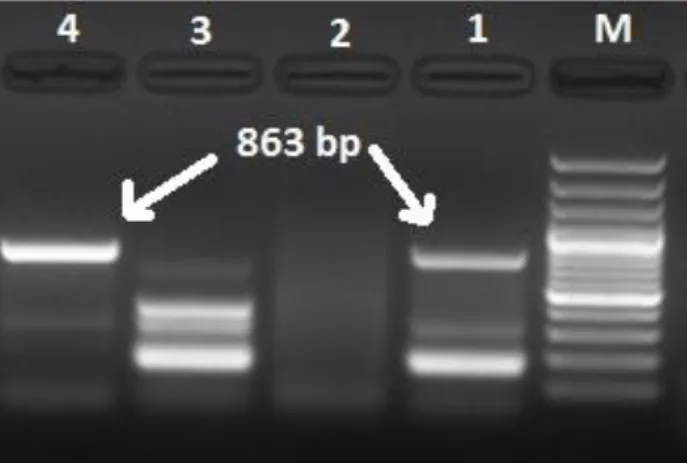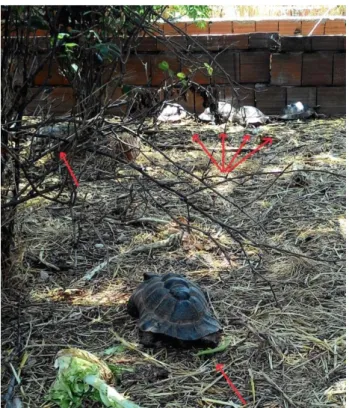Ankara Üniv Vet Fak Derg, 63, 407-410, 2016
Short Communication / Kısa Bilimsel Çalışma
First isolation of enteropathogenic Escherichia coli from land turtles
(Testudo graeca ibera) cultured in Turkey
Meriç Lütfi AVSEVER
1, Serra TUNALIGİL
21
Aksaray University, Eskil Vocation of High School, Laboratory and Veterinary Sciences, Aksaray; 2Bornova Veterinary Control Institute, Veterinary Biological Material Control Unit, Izmir, Turkey.
Summary: Enteropathogenic Escherichia coli was isolated from the internal organs and intestinal contents of 3 land turtles submitted to the laboratory for diagnostic purposes from a turtle farm located in western Turkey. As a result of the antibiotic susceptibility testing, isolates showed intermediated susceptibility to ceftiofur and gentamycine. This is the first report of the disease in turtles in Turkey.
Keywords: Escherichia coli, Testudo graeca ibera.
Türkiye’de kültürü yapılan kara kaplumbağalarından (Testudo graeca ibera) ilk enteropatojenik
Escherichia coli izolasyonu
Özet: Türkiye’nin batısındaki bir kaplumbağa çiftliğinden hastalık teşhisi amacıyla gönderilen üç yavru kara kaplumbağasının iç organ örnekleri ve bağırsak içeriklerinden enteropathogenic Escherichia coli izole edildi. Yapılan antibiyogram testinde izolatların ceftiofur ve gentamisine orta derecede duyarlı olduğu tespit edildi. Bu veriler ülkemizde kaplumbağalardan sağlanan ilk hastalık verileridir.
Anahtar sözcükler: Escherichia coli, Testudo graeca ibera.
Turtles are reared as pets as well as being wild animals. Turtle farms exist in many countries (China, Japan, Southeast Asia, United States, Caribbean, Europe) including Turkey. Rearing these animals with a high population density may cause an increase in disease prevalence. Aeromonas spp., Pseudomonas spp.,
Citrobacter spp., Mycoplasma spp., are among the most
important bacterial agents of turtles (6, 8, 10). Enteropathogenic E. coli is the other microorganism closely associated with mortalities in turtles (12, 13).
Turtles can be carriers for many zoonotic bacteria. Most important ones are Edwardsiella spp.,
Mycobacterium spp., and Salmonella spp. In the United
States of America, in 1960’s 14% of Salmonella cases in children were related to turtles; as a result the turtle production lines were prohibited till the establishment of Salmonella free farms in 1971 (2, 5, 10). However, enteropathogenic E. coli found incidentally in turtles, especially can cause infections in children who play with them.
Economic impact of turtle farming is also important. The farm where this study was carried out had a population of 50.000 land turtles and the annual export
revenues to European countries were stated to be around 100.000 Euros. The choice of turtles as pets in Europe may be due to their easy maintenance and lack of any harmful impact on the environment as well as a superstition about turtles bringing luck to the household (6).
Still, turtle farming is relatively new in Turkey and the diseases of the land tortoise is one of the least studied areas. The aim of this study is to present a case caused by enteropathogenic E. coli, to create awareness about turtle farming and to draw attention to the zoonotic diseases of turtles.
In this work, after mortalities occured in turtles reared in a farm in western Turkey, 3 newly dead turtles (1 adult, no 3; 2 juveniles, no 1 and 2) were submitted to the laboratory. Case history revealed that mortalities occured in adults within few days following diarrhea and without any symptoms in the young. During the necropsy, after an incision in the midsection of the bodies, internal organs were exposed. Macroscopically; exudate formation in the lungs and enteritis were the findings in the adult, while in the young, enteritis was observed (Figure 1). Liver, spleen and lung samples were
Meriç Lütfi Avsever - Serra Tunalıgil 408
streaked onto Columbia blood agar (Oxoid) and MacConkey agar (Merck) plates. Also, enrichment of intestinal samples was carried out in Rappaport Vassiliadis (RVS) Broth (Merck) and Muller Kauffmann Tetrathionate Broth (Oxoid), afterwards inoculations from these media were made on MacConkey Agar. Inoculated media were incubated under aerobic conditions at 37C for 24 hours (12).
Figure 1. Enteritis in the young (number 1).
Şekil 1. Genç kaplumbağada enteritis (1 nolu kaplumbağa).
Figure 2. The gel electrophoresis image showing the presence of eae genes in E. coli isolates from turtles. M: Marker, 100 bp. Line 1: Positive control, E. coli field isolate (from no 1 turtle), 863 bp. Line 2: Negative control, distilled water. Line 3: Negative control, no enteropathogenic E. coli isolate (from a lamb), Line 4: E. coli field isolate (from no 1 turtle), 863 bp. Şekil 2. Kaplumbağalardan izole edilen E. coli izolatlarındaki
eae gen varlığını gösteren jel elektroforez resmi. M: Marker,
100 bp. Sütun 1: Pozitif control, E. coli saha izolatı (1 no’ lu kaplumbağadan), 863 bp. Sütun 2: Negatif control, distile su. Sütun 3: Negatif control, enteropatojenik olmayan E. coli suşu (kuzudan), Sütun 4: E. coli saha izolatı (2 no’ lu kaplumbağadan), 863 bp.
Colonies were identified by conventional microbiological methods (3, 12) and Vitek 2 Compact identification system. According to these results E. coli was isolated from the internal organs and intestinal contents of turtles. After isolates were subcultured on Minca Agar (Sifin), serum agglutination test was performed with K99 antiserum (7). E. coli B41 referance strain (0101:K99/F41) was used as a positive control. The presence of eae gene encoding the intimin protein to verify enteropatogenic features of the E. coli isolates was investigated with PCR (14). As positive control, one of
E. coli isolates forming the clear band in the PCR. As
negative control, distilled water and no enteropathogenic
E. coli isolate were used.
The primer sequences were SK1-fo CCCGAATTCGGCACAAGCATAAGC and SK2-re
CCCGGATCCGTCTCGCCAGTATTCG. PCR
amplification was performed in a 25 µl volume with 1 × PCR buffer (2 mM MgCl2), 0.2 mM of each deoxynucleoside triphosphate (dNTP), 0.2 µM of each primer, 2.5 U Taq DNA polymerase (MBI, Fermantas) and 2 ng of template DNA. The eae PCR assay specific for E. coli eae gene was performed for 30 cycles at 94C for 30 s, 52C for 60 s, and 72C for 60 s preceded by an initial incubation at 94C for 2 min and followed by a final extension step at 72C for 5 min (Techne, TC-412). After PCR amplification, 4 µl of each product was added into a 1.0% agarose gel, electrophoresed (Thermo, PrimoTM). DNA sizemarker 100 DNA Ladder (MBI Fermentas) was used. Bands (863 bp) were visualised with designated equipment (Vilber Lourmant, E-BOX VX5) (Figure 2). As a result, E. coli isolates from turtles were seen to be enteropathogenic. Isolates’ antibiotic susceptibility patterns were investigated with the disc diffusion method (1)and zones were evaluated according to reference values (4, 9). E. coli isolates were seen to be susceptible to cefiofur (30 μg) and gentamycine (10 μg), and resistant to florfenicol (30 μg), penicillin G (10 μg), streptomycine (10 μg), oxytetracycline (30 μg), trimethoprim-sulfamethoxazole (25 μg), amoxycillin (25 μg) and enrofloxacin (5 μg) (Oxoid). A field visit was organized after reporting period to the farm so that test results could be relayed and discussed with the producers (Figure 3). During the inspection of the grounds, a poultry farm was seen to be located nearby the premises with its ventilation exhaust directed towards the facility. Also, a large number of stable flies were observed to swarm in the farm and producers were advised to take the necessary biosafety and hygiene measures.
Nowakiewicz et al. (11), as a result of their work on the cloacal swabs of 130 turtles raised in a controlled environment, reported the isolation of 17 different bacterial species in juvenile turtles and 36 different
Ankara Üniv Vet Fak Derg, 63, 2016 409
species in adults. Most common isolates in juveniles were Cellulomonas flavigena (77/96), Enterococcus
faecalis (96/96), E. coli (58/96) and Proteus mirabilis
(41/96); while in adults, isolates showed more diversity and zoonotic quality. They were Salmonella enterica
serovars Newport, Daytona and Braenderup; Listeria monocytogenes, Yersinia enterocolitica, Yersinia ruckeri,
Klebsiella pneumoniae, Vibrio fluvialis, Serratia
marcescens, Aeromonas sobria, Aeromonas caviae, Hafnia alvei, Edwardsiella tarda and Citrobacter braakii. The results obtained in this work are compatible
with this report.
In this work, symptoms of the E. coli infection found in the turtles are generally compatible with the findings of Owuamanam et al. (12), the only exception being the exudate formation in the lungs. This presentation in the lungs can be interpreted as the existence of a secondary infection in which the agent is unable to grow due to suppression by E. coli. On the other hand, Owuamanam et al. (12) have stated that, enteropathogenic E. coli isolated from turtles could be of human or environmental origin. The enteropathogenic E.
coli isolates from this work might also be contaminants
from an external source. Animal production facilities around the tortoise farm seem to be the likeliest source. The owner’s statement that the outbreak occured after the establishment of these neighboring facilities also strengthens this possibility. Still, further phylogenetic analyses are needed for a conclusive result.
Figure 3. A view of the tortoise farm. Şekil 3. Kaplumbağa çiftliğinden bir görüntü.
Although disinfection is of great importance in E.
coli outbreaks, it is not considered to be a practical
solution for the tortoise farm in question. As seen in Figure 3; the farming area was created by seperating a part of the natural environment. The bedding made up of dirt and grass was impossible to disinfect. For this reason the farm has to be transformed into a facility where appropriate disinfection and hygiene measures can be taken. Natural environment can cause parasitic invasions followed by secondary bacterial infections. Also, the large fly population in the premises may be an important problem. For these reasons, disease control strategies should be applied in turtle farms.
As a result, enteropathogenic E. coli was isolated from 3 land turtles from a turtle farm in Turkey. This is the first report of a disease outbreak in farmed land turtles in Turkey.
References
1. Alderman DJ, Smith P (2001): Development of draft
protocols of standard reference methods for antimicrobial agent susceptibility testing of bacteria associated with fish diseases. Aquaculture, 196, 211-243.
2. Alin K (1956): Salmonella in turtles, including a new type,
S. solna. Acta Pathol Microbiol Scand, 38, 71-72.
3. Arda M, Minbay A, Aydın N (1982): Bakteriyel
İnfeksiyöz Hastalıklar, Özel Mikrobiyoloji, A.Ü. Basımevi,
AU Vet Fak Yayın No. 386, Ankara.
4. Clinical and Laboratory Standards Institute (2001):
Performance standards for antimicrobial disk and dilution susceptibility tests for bacteria isolated from animals, 3rd
ed. Approved standard. M31-A3. CLSI, Wayne, Pennsylvania.
5. Harris JR, Bergmire-Sweat D, Schlegel JH, et al. (2009): Multistate outbreak of Salmonella infections
associated with small turtle exposure. Pediatrics, 124,
1388-1394.
6. Highfield AC (1996): Practical Encyclopedia of Keeping
and Breeding Turtles and Freshwater Turtles. Carapace
Press, London.
7. Guinee PAM, Jansen WH, Agterberg CM (1976):
Detection of the K99 antigen by means of agglutination and immunoelectrophoresis in Escherichia coli isolates from calves and its correlation with enterotoxigenicity.
Infect Immun, 13, 1369-1377.
8. Jeffery J (1999): The Veterinary Clinics of North America
Exotic Animal Practice. W.B. Saunders Co. Philadelphia,
PA.
9. Koneman EW, Allen SD, Janda WM, et al. (1997):
Colour Atlas of Diagnostic Microbiology, Fifth ed,
Lippincott.
10. Marcus LC (1968): Diseases of snakes and turtles. Curr Vet Ther, 11, 435-442.
11. Nowakiewicz A, Ziółkowska G, Zięba P, et al. (2015):
Aerobic bacterial microbiota isolated from the cloaca of the european pond turtle (Emys orbicularis) in Poland. J
Wildlife Dis, 51, 255-259.
12. Owuamanam CM, Ameen SA, Adedokun RAM (2012):
Meriç Lütfi Avsever - Serra Tunalıgil 410
coli in horsfields tortoise (Testudo horsfieldi) at zoological garden, University of Ibadan, Nigeria Global Veterinaria,
9, 717-719.
13. Rahımi E, Khamesipour F, Yazdı F, et al. (2012):
Isolation and characterization of enterohaemorragic Escherichia coli O157:H7 and EHEC O157:NM from raw bovine, camel, water buffalo, caprine and ovine milk in Iran. Kafkas Univ Vet Fak Derg, 18, 559-564.
14. Zhang WL, Köhler B, Oswald E, et al. (2002): Genetic
diversity of intimin genes of attaching and effacing Escherichia coli strains. J Clin Microbiol, 40, 4486-92.
Geliş tarihi:16.11.2015 /Kabul tarihi:19.01.2016
Address for correspondence:
Yrd. Doç. Dr. Meriç Lütfi AVSEVER Aksaray Üniversitesi,
Eskil Meslek Yüksek Okulu Laboratuvar ve Veteriner Bilimleri Eskil-Aksaray, Türkiye

